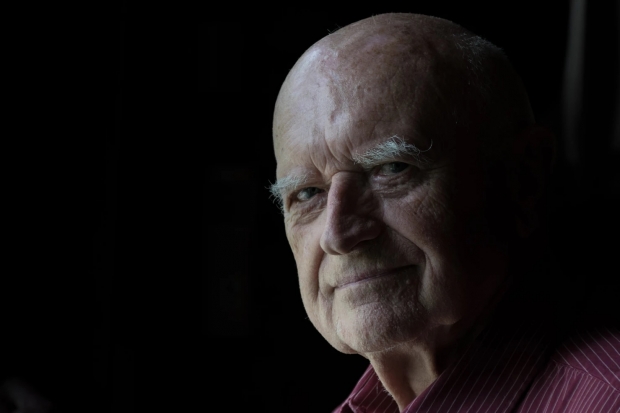Raoul Servais, known as the wizard of Ostend, passed away on Friday 17 March in his home in Leffinge, West Flanders, Belgium.
Raoul Servais, known as the wizard of Ostend, passed away on Friday 17 March in his home in Leffinge, West Flanders, Belgium. During his long career, he made 16 short films and 1 feature film. His films won numerous awards including the Golden Palme at the Cannes International Film Festival for Harpya in 1979. He was the first Belgian director to win a Palme d’Or for Best Short Film.
Harpya was chosen by International Film Critics as one of the 15 best-animated films of all time. In 1998, his short Nocturnal Butterflies received the Grand Prize at the Annecy International Film Festival as well as the International Film Critics Award.
Raoul was born on 1 May 1928 in Ostend, West Flanders where his parents owned a crystal and china shop. His father had a fascination with science and technology and on Sunday afternoons would show Charlie Chaplin, Charles Vanel, and Felix the Cat films with his Pathé Baby projector. Raoul became fascinated by films and how they were created at an early age.
On 10 May 1940, the Germans launched their panzer division’s attack on Belgium and left a deep imprint on the 12-year-old Servais. The horror of war is a theme that runs through many of his films.
The Royal Academy of Fine Art in Gent, Belgium did not have an animation department but while studying there, Raoul decided that he wanted to make an animated film. He had no camera, so he and his teacher created one out of a cigar box.
In 1953 Servais was hired to be part of a team headed by René Magritte to create a mural for a casino in Knokke, West Flanders. Magritte was a Belgian surrealist known for his depictions of familiar objects in unexpected contexts such as men in bowler hats with umbrellas raining down from the sky. His work often provoked questions about the nature and boundaries of reality. Through Magritte, Raoul discovered surrealism and its ambiguity, which fascinated him. He also began to develop his own personal style of art which fell somewhere in between expressionism and magical realism.
Servais never received any formal filmmaking education. This made him acutely aware of the need for an animation academy. In the 1960’s he founded the first animation training course in continental Europe at the Royal Academy of Fine Arts (KASK) in Gent, Belgium, West Flanders.
From 1985 to 1994 he was president of ASIFA (Association International du Film d’ Animation). In 2010 he was named an Honorary President of the organization.
International recognition came to Servais in 1979 with his comedy/horror film Harpya when it won the Golden Palm at Cannes. The film tells the story of a man who tries to live with a harpy, a mythical being that is half woman and half bird of prey with an insatiable appetite.
His next film, Taxandria (1994), takes place in a city where a totalitarian regime has banned the idea of time. There is no past or future, only the present. Watches and cameras have become illegal. The film had a large number of live-action scenes and was not a box-office hit.
Nocturnal Butterflies (1998) is an homage to the Belgian surrealistic painter Paul Delvaux (1897 to 1994). For this film Raoul used Servaisgraphy, his own patented technique, blending film images and animation. With this technique, the characters are photographed in black and white. Then they are printed onto cellophane, colored with gouache on the reverse side, and then integrated with the background.
The film enters a Delvaux painting where something strange is happening. A train station waiting room becomes the ballroom of a mysterious dancing woman.
Nocturnal Butterflies is the only film that was entirely made using the Servaisgraphy technique, which became obsolete because of the complicated labor that it required along with the development of digital technology.
In 2015 at the age of 87, Raoul had no intention of slowing down. For several years he had been developing 3 separate projects related to World War I One project, Tank, was inspired by Le Tank, written by the French pacifist poet Pierre Jean Jouve. It is about the new war machine that the British deployed against the Germans at the bloody battle of the Somme in September 1916. The Tank premiered at the Gent International Film Festival that year.
Raoul’s last film, Der Lange Kerl (The Tall Guy) (2021) was made with co-director Rudy Pinceel. The 93-year-old Servais said, “I directed at a distance and Rudy directed on-site”. The film is a parody of Prussian militarism with a pacifist and humanist message.
On 15 October 2022 Der Lange Kerl was presented as part of the Official Selection of the Gent International Film Festival. Raoul Servais was present to receive the Joseph Plateau Honorary Award for his rich and pioneering work in the field of Belgian animation.
Until the 12th of November, Raoul’s short film Chromaphobia (1965) will be showing in the amazing setting of a bunker at the open-air museum Atlantikwall Raversyde in Ostend. Each year the museum organizes an art exhibition in three German World War II bunkers. This year the theme is animated film and war. Chromaphobia is about a fascist regime with a chain of chromophobic soldiers who destroy colorful landscapes and flowers while suppressing the local population. The theme is as current today as when the film was made.
With the passing of Raoul Servais, the animation world has lost a great pioneering filmmaker. He leaves behind many animators who learned their art under his tutelage. He also leaves behind people who not only respected and revered him for his films but also for his warmth and friendship. He was a true gentleman. On a personal note, he is a friend who showed many small acts of kindness toward me that I will miss greatly.










